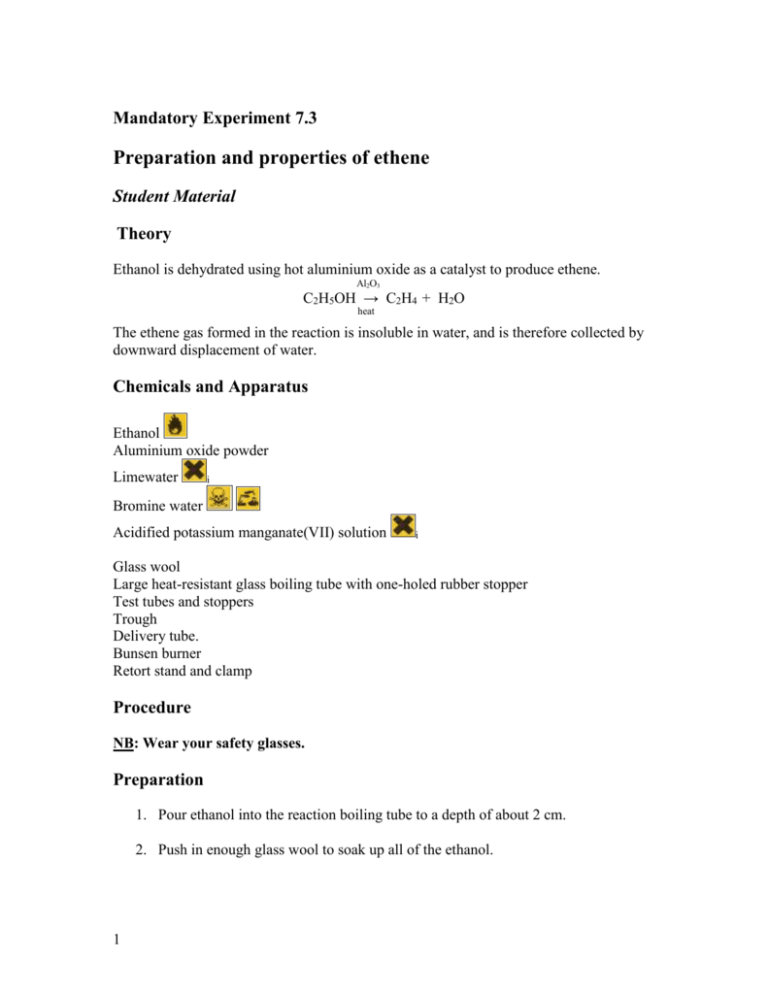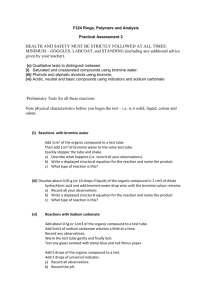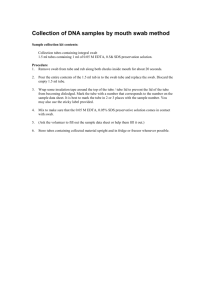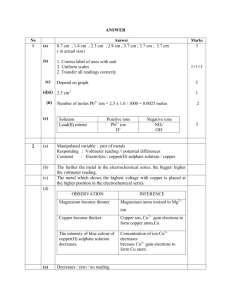EXPERIMENT NO
advertisement

Mandatory Experiment 7.3 Preparation and properties of ethene Student Material Theory Ethanol is dehydrated using hot aluminium oxide as a catalyst to produce ethene. Al2O3 C2H5OH → C2H4 + H2O heat The ethene gas formed in the reaction is insoluble in water, and is therefore collected by downward displacement of water. Chemicals and Apparatus Ethanol Aluminium oxide powder Limewater i Bromine water Acidified potassium manganate(VII) solution i Glass wool Large heat-resistant glass boiling tube with one-holed rubber stopper Test tubes and stoppers Trough Delivery tube. Bunsen burner Retort stand and clamp Procedure NB: Wear your safety glasses. Preparation 1. Pour ethanol into the reaction boiling tube to a depth of about 2 cm. 2. Push in enough glass wool to soak up all of the ethanol. 1 3. Set up the apparatus as shown in diagram, with about 2 g of aluminium oxide halfway along the boiling tube. 4. Heat the catalyst strongly, and occasionally heat the ethanol gently to drive the vapour over the catalyst. 5. Collect a few test tubes of ethene by displacement of water, stoppering the test tubes when they are filled. The first test tube filled can be discarded, as it contains a mixture of air and ethene. 6. When gas bubbles are no longer emerging from the delivery tube, remove the tube from the water, and then turn off the Bunsen burner. Investigation of Properties 1. Ignite the gas in one of the test tubes. Describe the flame (coloured or clear, smoky or clean). Pour a few drops of limewater into the test tube. Stopper, shake well and record what you see. 2. Add a few drops of diluted bromine water to the second test tube of gas. Stopper and shake well. Record what you see. 3. Add a few drops of acidified potassium manganate(VII) solution to a third test tube of the gas. Stopper immediately and shake well. Record what you see. 2 Questions relating to the experiment 1. Why is it desirable to push the glass wool into the tube after the ethanol has been added? 2. Why should the ethanol not be heated strongly? 3. Would you expect all the test tubes of gas collected to contain equally pure samples of ethene? Explain your answer. 4. Why is it very important to remove the delivery tube from the water as the Bunsen burner is turned off? 5. In each of steps 1,2 and 3 in the investigation of properties, give a reason for the results observed. 3 Teacher Material Bromine water should be diluted to give a pale yellow solution. This is done to ensure that decolourisation occurs readily. Acidified potassium manganate(VII) solution should be diluted further to give a pale pink solution. This is done to ensure that decolourisation occurs readily. When testing for unsaturation, an alternative to adding bromine water or acidified potassium manganate(VII) solution to a test tube of gas is to bubble the gas directly into a small volume of solution as the gas is being produced. Preparation of reagents Bromine water can be purchased directly from laboratory suppliers. Alternatively, it can be made up by shaking 0.5 cm3 of bromine in a fume cupboard with 100 cm3 of water. If bromine water is being prepared from bromine, it is essential to do this in the fume cupboard, wearing rubber gloves. The solution deteriorates with time. Store in a tightly stoppered brown bottle. Acidified potassium manganate(VII) solution can be prepared by mixing 10 cm3 of approximately 0.02 M KMnO4 with 20 cm3 of dilute H2SO4. Limewater is prepared by adding about 200 g of calcium hydroxide to 2.5 l of water. Calcium hydroxide has a low solubility in water. Shake vigorously at intervals over a period of time and finally allow to settle. Decant off the clear limewater solution from above the undissolved solids. Top up the vessel with deionised water and repeat the process. Quantities per working group The volume of ethanol required will depend on the diameter of the reaction tube. A depth of about 2 cm should be sufficient. About 2 g of aluminium oxide is required. A few drops of bromine water, of acidified KMnO4 solution, and of limewater will suffice. If excess is used, the required colour changes may not materialise. Safety considerations 4 Safety glasses must be worn. Ensure that the reaction tubes are made of heat resistant glass. Avoid suck-back at the end of the experiment by lifting the apparatus clear of the trough. Some texts suggest loosening the stopper in the reaction tube, but rubber stoppers tend to stick to hot glass and are difficult to remove quickly. Chemical hazard notes Ethanol : Highly flammable; keep away from sources of ignition. Bromine: : The vapour is highly toxic by inhalation. The liquid causes severe burns to eyes and skin. The aqueous solution attacks lungs, eyes and nose. Acidified potassium manganate(VII) solution i: Oxidising agent - the solution used here is irritating to the skin and eyes. Wash any splashes off the skin. Calcium hydroxide Limewater i: i: Irritant to eyes, skin and lungs. Splashed droplets in the eye cause severe irritation. Disposal of wastes Mix the aluminium oxide and glass wool residue with excess sand, and place in refuse bin. Neutralise the bromine water residue with 10% sodium carbonate solution, and dilute with water. Flush to foul water drain. Add sodium metabisulfite with stirring to the acidified potassium manganate(VII) solution residue until the solution is colourless. Flush to foul water drain. Suggested solutions to student questions 1. Why is it desirable to push the glass wool into the tube after the ethanol has been added? To ensure that all of the ethanol is soaked up. 2. Why should the ethanol not be heated strongly? Strong heating of the ethanol will cause it to evaporate too quickly and escape from the tube before it can be dehydrated. 3. Would you expect all the test tubes of gas collected to contain equally pure samples of ethene? Explain your answer. 5 The first test tubes of gas collected will contain air and ethanol vapour as well as ethene. Subsequent test tubes of gas collected will contain ethene only. 4. Why is it very important to remove the delivery tube from the water as the Bunsen burner is turned off? To avoid cold water being sucked back from the trough onto the hot glass of the reaction tube. 5. In each of steps 1,2 and 3 in the investigation of properties, give a reason for the results observed. Step 1: The limewater is turned milky by the carbon dioxide formed by the combustion of ethene. Steps 2 and 3: The decolourisations indicate unsaturation. Industrial Uses Alkenes are the raw materials for addition polymerisation. Ethene itself is used to make polythene, and substituted ethenes are used to make a range of other plastics. Ethene may also be used for the manufacture of ethanol. 6








